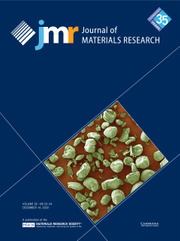Crossref Citations
This article has been cited by the following publications. This list is generated based on data provided by
Crossref.
Zhao, L.
Chien, A. T.
Lange, F. F.
and
Speck, J. S.
1997.
Defect Generation And Evolution In The Hydrothermal Growth Of Epitaxial BaTiO3Thin Films.
MRS Proceedings,
Vol. 474,
Issue. ,
Chien, A. T.
Zhao, L.
Colic, M.
Speck, J. S.
and
Lange, F. F.
1998.
Microstructural development of BaTiO3 heteroepitaxial thin films by hydrothermal synthesis.
Journal of Materials Research,
Vol. 13,
Issue. 3,
p.
649.
Schwartz, Robert W.
Clem, Paul G.
Voigt, James A.
Byhoff, Elena R.
Van Stry, Melanie
Headley, Thomas J.
and
Missert, Nancy A.
1999.
Control of Microstructure and Orientation in Solution‐Deposited BaTiO3 and SrTiO3 Thin Films.
Journal of the American Ceramic Society,
Vol. 82,
Issue. 9,
p.
2359.
Langjahr, P. A.
Wagner, T.
Rühle, M.
and
Lange, F. F.
1999.
Thermally induced structural changes in epitaxial SrZrO3films on SrTiO3.
Journal of Materials Research,
Vol. 14,
Issue. 7,
p.
2945.
Bagwell, Roger B.
Sindel, Jürgen
and
Sigmund, Wolfgang
1999.
Morphological evolution of barium titanate synthesized in water in the presence of polymeric species.
Journal of Materials Research,
Vol. 14,
Issue. 5,
p.
1844.
Wei Lu, Song
Lee, Burtrand I.
Lin Wang, Zhong
and
Samuels, William D.
2000.
Hydrothermal synthesis and structural characterization of BaTiO3 nanocrystals.
Journal of Crystal Growth,
Vol. 219,
Issue. 3,
p.
269.
Tamaki, Jun
Goh, Gregory K. L.
and
Lange, Fred F.
2000.
Novel epitaxial growth of barium titanate thin films by electrodeposition.
Journal of Materials Research,
Vol. 15,
Issue. 12,
p.
2583.
Grohe, B.
Miehe, G.
and
Wegner, G.
2001.
Additive controlled crystallization of barium titanate powders and their application for thin-film ceramic production: Part I. Powder Synthesis.
Journal of Materials Research,
Vol. 16,
Issue. 7,
p.
1901.
Moon, Jooho
Suvaci, Ender
Li, Tuo
Costantino, Stephen A
and
Adair, James H
2002.
Phase development of barium titanate from chemically modified-amorphous titanium (hydrous) oxide precursor.
Journal of the European Ceramic Society,
Vol. 22,
Issue. 6,
p.
809.
2002.
(Ba1-xCax)(Ti1-yZry)O3Powder Synthesis Via Hydrothermal Treatment.
Journal of the Korean Ceramic Society,
Vol. 39,
Issue. 11,
p.
1017.
Outzourhit, A.
El Idrissi Raghni, M.A.
Hafid, M.L.
Bensamka, F.
and
Outzourhit, Abdelkader
2002.
Characterization of hydrothermally prepared BaTi1−xZrxO3.
Journal of Alloys and Compounds,
Vol. 340,
Issue. 1-2,
p.
214.
Szafraniak, I.
Harnagea, C.
Scholz, R.
Bhattacharyya, S.
Hesse, D.
and
Alexe, M.
2003.
Ferroelectric epitaxial nanocrystals obtained by a self-patterning method.
Applied Physics Letters,
Vol. 83,
Issue. 11,
p.
2211.
Wang, Xinyu
Lee, B. I.
Hu, M. Z.
Payzant, E. A.
and
Blom, D. A.
2003.
Mechanism of nanocrystalline BaTiO3 particle formation by hydrothermal refluxing synthesis.
Journal of Materials Science: Materials in Electronics,
Vol. 14,
Issue. 8,
p.
495.
Moon, Jooho
Suvaci, Ender
Morrone, Augusto
Costantino, Stephen A.
and
Adair, James H.
2003.
Formation mechanisms and morphological changes during the hydrothermal synthesis of BaTiO3 particles from a chemically modified, amorphous titanium (hydrous) oxide precursor.
Journal of the European Ceramic Society,
Vol. 23,
Issue. 12,
p.
2153.
Gersten, Bonnie L.
2003.
Crystal Growth Technology.
p.
299.
Huang, Qing
and
Gao, Lian
2004.
Synthesis and Characterization of Hexapod‐Shaped Tetragonal‐Phase Barium Titanate Single Crystals.
Journal of the American Ceramic Society,
Vol. 87,
Issue. 7,
p.
1350.
Messing, G. L.
Trolier-McKinstry, S.
Sabolsky, E. M.
Duran, C.
Kwon, S.
Brahmaroutu, B.
Park, P.
Yilmaz, H.
Rehrig, P. W.
Eitel, K. B.
Suvaci, E.
Seabaugh, M.
and
Oh, K. S.
2004.
Templated Grain Growth of Textured Piezoelectric Ceramics.
Critical Reviews in Solid State and Materials Sciences,
Vol. 29,
Issue. 2,
p.
45.
Alexe, M.
Harnagea, C.
and
Hesse, D.
2004.
Non-Conventional Micro- and Nanopatterning Techniques for Electroceramics.
Journal of Electroceramics,
Vol. 12,
Issue. 1-2,
p.
69.
Testino, Andrea
Buscaglia, Maria Teresa
Buscaglia, Vincenzo
Viviani, Massimo
Bottino, Carlo
and
Nanni, Paolo
2004.
Kinetics and Mechanism of Aqueous Chemical Synthesis of BaTiO3 Particles.
Chemistry of Materials,
Vol. 16,
Issue. 8,
p.
1536.
Yosenick, Timothy J.
Miller, David V.
Kumar, Rajneesh
Nelson, Jennifer A.
Randall, Clive A.
and
Adair, James H.
2005.
Synthesis of nanotabular barium titanate via a hydrothermal route.
Journal of Materials Research,
Vol. 20,
Issue. 4,
p.
837.

